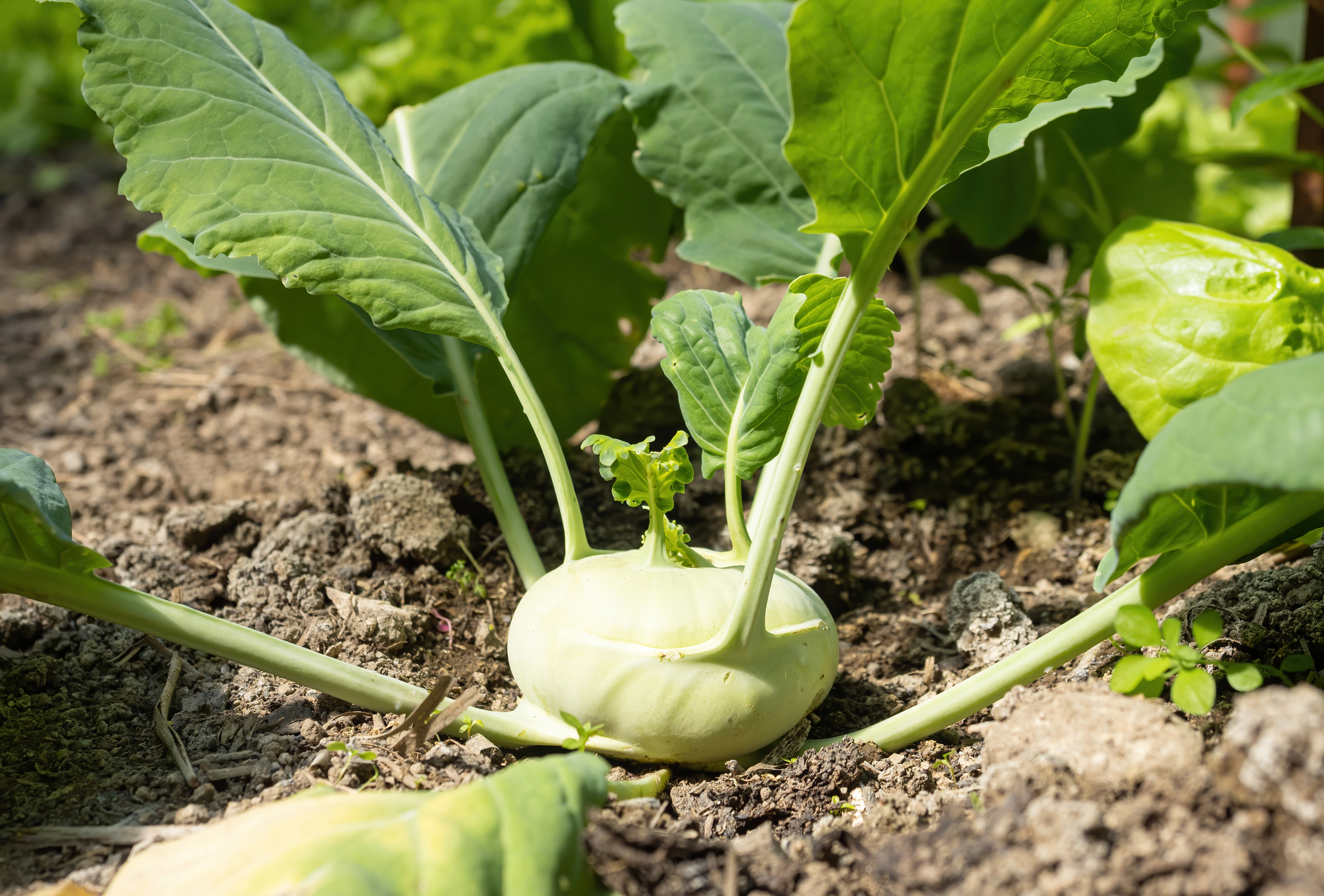Kohlrabi Donation Tracker
Quick Links: How & Where to Grow | Temperature | How to Care For | Harvest Signs | Harvesting | Pruning | Pests | Companions | Varieties | Preservation | Recipes | Michigan Tips | Fun Facts
🌱 How & Where to Grow Kohlrabi:
- Direct seed April-May and July-August.
- Quick-growing (50-60 days) – the UFO of the vegetable garden!
- Space plants 6 inches apart in rows 12 inches apart.
- Sunlight: Full sun (6+ hours) but tolerates partial shade.
- Soil Type: Well-drained, fertile soil with pH 6.0-7.5.
- Soil Amendment: Moderate compost – not a heavy feeder
Kohlrabi looks like an alien spaceship but tastes like a sweet, mild turnip crossed with cabbage!
🌡️ Temperature Guidance:
Optimal 60-70°F. Tolerates 25°F. Hot weather = woody bulbs.
- Best growth: 60-70°F consistent temperatures.
- Spring planting: As soon as soil can be worked.
- Mature plants tolerate frost to 25°F.
- Heat above 75°F causes woody, tough texture.
Michigan’s cool springs and falls are perfect – summer heat is kohlrabi’s enemy!
💧 How to Care for:
- Consistent Moisture: Essential for tender, non-woody bulbs.
- Watering: 1 inch weekly – steady moisture prevents toughness.
- Mulch: Light mulch to retain moisture.
- Fertilizer: Light feeding at planting is sufficient.
- Fast growth: Keep them growing quickly for best quality.
📏 Harvest Signs:
2-3 inches diameter. Don’t exceed 4 inches. Firm feel.
- Size is everything – harvest young for best texture!
- Tennis ball size (2-3 inches) is perfect.
- Larger than 4 inches becomes woody and tough.
- Should feel firm and heavy for size.
Don’t wait too long – kohlrabi grows fast and gets woody quickly!
🧺 Harvesting:
Pull entire plant or cut at soil level. Trim leaves and roots.
- Always harvest when soil is moist for easy pulling.
- Grasp bulb and pull straight up.
- Or cut at soil level with sharp knife.
- Remove leaves and roots immediately.
- Leaves are edible – use like collard greens!
✂️ Pruning:
Remove lower leaves as bulb forms. Harvest leaves for eating.
- Minimal pruning needed due to quick growth.
- Remove yellowing lower leaves for cleaner bulbs.
- Harvest young leaves for cooking – won’t harm bulb.
- Keep 4-5 top leaves to feed bulb growth.
- No topping needed – let it grow!
🪲 Michigan Pests:
Root maggots, flea beetles, aphids (minor due to quick growth).
- Root maggots – most serious pest. Use row covers.
- Flea beetles – tiny holes in leaves. Less damaging than on other crops.
- Aphids – occasional problem, blast with water.
- Quick growth helps outpace most pest problems!
🫱🏽🫲🏼 Companions:
Lettuce, spinach, onions, herbs, beans, radishes.
- Lettuce and spinach grow well in kohlrabi’s shade.
- Onions help deter pests.
- Radishes can be interplanted – similar growth rate.
- Beans fix nitrogen for following crops.
- Herbs like dill attract beneficial insects.
🛸 Varieties:
Early: ‘Kolibri’, ‘Winner’. Storage: ‘Korridor’, ‘Superschmelz’.
- ‘Kolibri’: 45 days, purple, sweet and tender.
- ‘Winner’: 45 days, light green, very uniform.
- ‘Korridor’: 55 days, stays tender at larger size.
- ‘Superschmelz’: 60 days, grows huge without getting woody!
- ‘Early White Vienna’: 55 days, classic variety.
🫙 Preservation:
Fresh 2-3 weeks. Freeze blanched cubes. Root cellar large varieties.
- Fresh storage: Remove leaves, store 2-3 weeks in crisper.
- Freezing: Blanch cubes 3 minutes before freezing.
- Root cellar: Storage varieties keep 2-3 months.
- Pickling: Makes great refrigerator pickles.
- Fermented: Use like turnips in sauerkraut.
- Dehydrated: Makes interesting veggie chips.
🧑🏽🍳 Recipes:
Kohlrabi slaw, roasted wedges, kohlrabi fries.
- Raw kohlrabi slaw with apple and cabbage.
- Roasted kohlrabi wedges with parmesan.
- Kohlrabi fries – better than potato fries!
- Cream of kohlrabi soup.
- Stuffed kohlrabi – hollow out and fill with grains.
✋🏼 Michigan Tips:
- Perfect for succession planting.
- Spring and fall crops both successful.
- Quick maturity beats pest problems.
- Grows well in containers.
- Michigan’s variable weather doesn’t faze it.
- Storage varieties extend harvest season.
🧠 Fun Facts:
- “Cabbage turnip” in German.
- Swollen stem, not root.
- NASA studied for space agriculture.
- Kohlrabi is actually a swollen stem, not a root or bulb!
- First recorded in Europe in 1554.
- Popular in Kashmir where it’s called “monj.”
- Purple varieties turn green when cooked.
- Contains more vitamin C than oranges – especially the leaves!


0 Comments